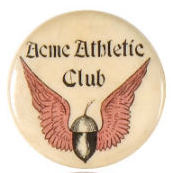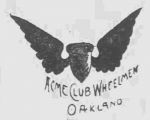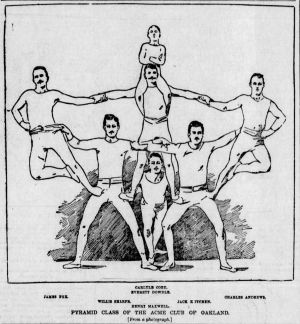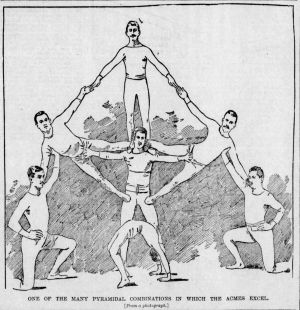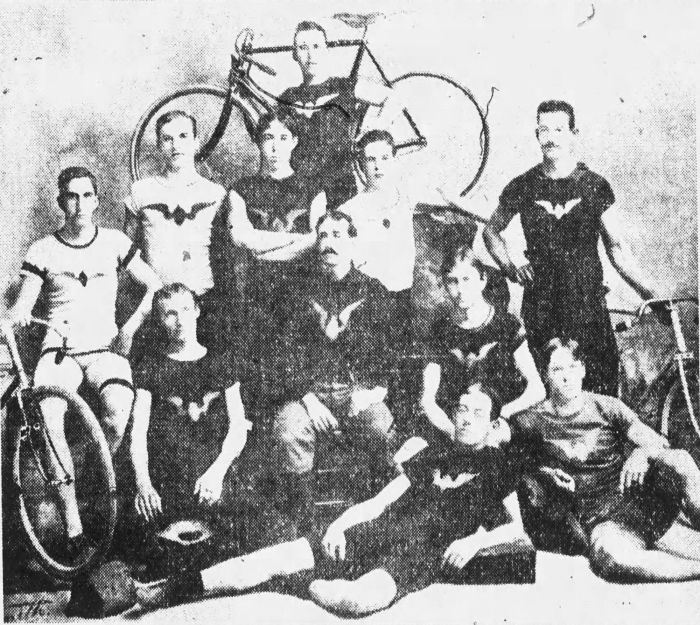Acme Wheelmen
https://fastestslowguy.blogspot.com/search?q=acme
See also: Acme Athletic Club, Acme Athletic Club Reunions
Place
Oakland, CA
Emblem
a winged acorn in red and black
Members
- A. H. Agnew
- J. J. Allen
- A. Belding
- Grant Bell
- Albert A. Bouton
- Charles Bowman
- Bert Brown
- W. A. Burke
- J. M. Calhoun
- Ned Campbell
- Casey Castleman
- Frank Cooley
- John F. Conners
- G. H. Crafts
- E. W. Decker
- Everett S. Dowdle
- Jim Drew
- George A. Faulkner
- B. Ferris
- Joe Fields
- J. W. Finigan
- S. S. Fogarty
- Jimmy Fox
- H. R. French
- J. Grindley
- Jeremiah J. Hanifin, Jr.
- Charles Hannan
- L. W. Hardie
- Ross Hardy
- J. B. Harris
- Rufus Hepburn
- J. A. Howard / Jack Howard
- Billie Hughes
- Henry Hutchinson
- Jack Kitchen Jr.
- J. R. Kenna
- Louis A. Lamory
- Frank Leavett
- Peter Lefevre / Pete Le Fevre
- B. C. Leslie
- Burton Clarence Lund
- Charles H. Lutkey
- H. A. Maxwell
- Ed Merwin
- G. F. Mier
- Percy R. Mott
- O. C. Musser
- George F. Neece
- G. A. Nissen
- A. J. Patterson
- O. L. Pickard
- J. M. Polk
- Steven Rice
- Joe Rose
- Manuel F. Rose
- J. R. Sampson / J. A. Sampson / Samson / Jack Sampson
- T. F. Scanlon / Tim Scanlon
- Theodore A. Schlueter
- James M. Shanly
- Frank Willis Sharpe
- George Simpson
- H. N. Sloper
- E. J. Smith / Eddie Smith
- Walter Smythe
- H. Snow
- M. A. Squired
- H. W. Squires
- George Stultz
- Alfred Plaisted Swain
- DeWitt C. Van Court
- Eugene Van Court
- S. R. Van Wyck
- Frank J. Waller
- Myron A. Whidden
- Eddie Wilcox
The Acme Athletic Club was founded in 1881, and went bust in 1899, (Acme Cub will disband... members of the Acme Club will be taken into the Reliance.) It was due to embezzlement, financial mismanagement, the bust of the 1890s; something like that. A new Acme Bicycle Club was formed in 1910 in Oakland, and by 1912 they were calling themselves the Acme Wheelmen, but it disappeared from the newspapers around 1916, which was around the end of the first bike boom. Providentially, for me, the members of the original Acme Athletic Club started having reunions in 1919, which continued into the 1950s. Those are good stories.
See also Acme Athletic Club Reunions, Acme Athletic Club.
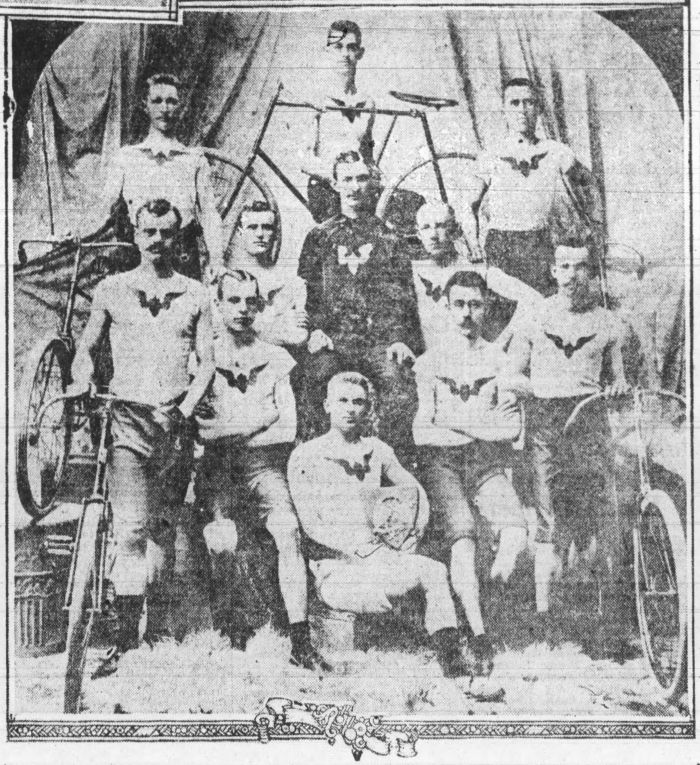
Oakland Tribune Oakland, California 18 Dec 1921, Sun • Page 31
What has become of the Acme Bicycle Club, the adjunct of the Acme Athletic Club? How short lived have been all our cycling organizations, and which goes next!
WHEEL WHIRLS. - Oakland Tribune, 24 Sep 1890
ACME WHEELMEN.
A Bicycle Club Formed at the Acme Clubrooms.
A number of the athletes of the Acme Athletic Club held a meeting at the clubrooms last night and formed the Acme Bicycle Club. The following signed the roll: Charles Bowman, E. S. Dowdle, S. S. Fogarty, J. J. Hanifin, L. A. Lamory, B. C. Leslie, H. A. Maxwell, G. F. Mier, O. L. Pickard, Steven Rice, T. F. Scanlon, F. W. Sharpe, H. N. Sloper, D. C. Van Court, M. A. Whidden, B. Ferris.
T. F. Scanlon of the Acme Club is an expert wheelman and has been teaching many of the boys how to mount a wheel. A few evenings ago Ned Campbell of the Dirigo was initiated. Ned can now ride a safety wheel in fair style.
Myron Whidden and J. J. Hanifin Jr. can be seen riding through the streets almost every evening.
The Alameda County Wheelmen will hold a run next Sunday to Haywards.
1891/07/22 ACME WHEELMEN. - Oakland Tribune
The Acme Athletic Club of Oakland has organized a bicycle club, with the following named as charter members: D. C. Van Court, M. A. Whidden, H. M. Sloper, B. Ferris, T. F. Scanlan, S. Rice, O. L. Pickard, H. H. Maxwell, G. F. Mier, B. C. Leslie, S. S. Fogarty, C. Bowman, E. S. Dowdle, J. J. Hanifin and L. L. Lamory.
The San Francisco Call, 02 Aug 1891, Sun
At the annual election of officers of the Acme Athletic Club's Wheelmen the following were elected for the ensuing year: J. J. Hanifin Jr., captain ; L. A. Lamory, first lieutenant; E. S. Dowdle, second lieutenant; O. L. Pickard, bugler; Charles Lutkey, secretary. The initial run of the club under the new management was held last Sunday to the Cliff House. There were 28 members in line, and on returning to Oakland they adjourned to a restaurant, where a fine dinner was served. The line was then re-formed and the run continued to San Leandro. The newly elected captain is one of the old-time members, and is very popular with the boys. He will no doubt prove a very efficient officer, and is ably seconded by his lieutenants.
CHAT ABOUT THE CYCLE. - The Steady Growth of the New California Club. - The San Francisco Call, 01 Aug 1892
HOME OF THE FAMOUS ACMES
An Oakland Club Which Houses Champions of all Descriptions
PYRAMIDS MADE A SPECIALTY.
How the Influential Amateur Organization From Small Beginnings Became an Affair of Vast Importance - Personnel of Those Who Have Achieved Fame In Different Departments of Sport
Born in a barn and matured in a Chinese wash-house the Acme Athletic Club of Oakland has risen to such importance that it is now able to produce at least as good athletes as those turned out by the famous Olympic Club of San Francisco. Some of the Acmes championship men have won their laurels from the Olympic champions and the intervention of several years has not been enough to regain for that organization its lost honors. The Acme Club of to-day has some remarkable athletes among its members. In athletic sports of all kinds as well as bicycling, aquatics and the more difficult pyramid building the symbol of the winged acorn has never had to take second place and the boys are determined that it never will. The early history of the club is as interesting as its later development into the fore most athletic organization in Alameda county. Way back in the fall of 1881 a handful of young men living in the vicinity of Sixth and Alice streets with nothing to occupy their time after school rigged up a swinging trapeze in an oak tree in De Witt Van Court's back yard, and this broomhandle trapeze, together with an ancient pair of boxing gloves, were the only apparatus the club owned.
The members of the club at that time were: DeWitt C. Van Court. Eugene Van Court, O. C. Musser, George Faulkner and J. M. Polk, all being neighbors and living within a few blocks of the Van Court residence. The early meetings of the club were held in the Van Court back yard whenever the rain permitted. In course of time the boys obtained permission from Mrs. Dr. Lafevre [Lefevre] to use the loft of a barn close by. The roof of this barn was so low that but one member could exercise at a time, and while he was busy swinging clubs or two others were boxing the rest of the club sat down and did their best to keep out of the way. From this early stage the club progressed by steady growth until it was able to rent an old China washhouse at the corner of Eighth and Webster streets. Here the membership was increased by the admission of Tim Scanlon, Ed Merwin, Rufus Hepburn, Ross Hardy and John F. Conners. Those, with the original members, afterwards became charter members when the Acme Athletic Club was formed.
From this time on the club grew rapidly, moving first to College Hall, at the corner of Twelfth and Harrison streets, and later to the old Synagogue building on Fourteenth street, which had been especially fitted up for the club's use. It was less than a year ago that the club moved into its own building, on Twelfth street, near Broadway, and its progress since it was first organized has been little short of a marvel.
One of the best features of the club has been its selection of officers. It always has had progressive men to direct it. When the club became important enough to have a boxing master of its own Walter Watson of England, who held the rank of champion boxer of America at the time, was installed in that all-important position. Watson also taught the young men of the Olympic Club how to defend themselves, and on every Acme class night Watson brought an Olympic pupil of his across the bay to box with the Acme men. The records yet fail to show an occasion on which an Olympia boxer went home victorious.
It was these matches with the Olympics that gave the Acme Club its first standing in the community, and ever since that time the two clubs have held many an interesting tournament together. It was at one of these tournaments that Jack Kitchen of the Acme Club became the first champion the club ever had. He won from the Olympic Club the title of amateur heavyweight champion boxer of the Pacific Coast. Kitchen has held this title for about three years, and since that time championships have been liberally distributed among the club members, until now the walls of the clubrooms are literally lined with life-size photographs of champions, who have won fame in every branch of athletics, from tests of strength in gymnasium and field to feats of endurance in a swimming tank.
One of the club's most interesting features, and which never fails to afford pleasure to its lady visitors, is the acrobatic band that form the pyramid tableaux. The members of this corps are Jack Kitchen and James Fox, the club's two champion boxers; Charlie Andrews, champion wrestler: Harry Maxwell, E. S. Dowdle, Willis Sharpe and Carlisle Coey. These tumblers have eighteen forms of pyramids they make with lightning rapidity. The men are all dressed in white, with powdered wigs, and on exhibition nights they resemble so many statues, so perfect is their work.
One of the most interesting groups consists of Dowdle "doing a crab" on the backs of Sharpe and Kitchen, with the little Coey boy perched at the top of the group, and the others grouped picturesquely around. Then there is the "single strong man," in which Kitchen supports three men pyramid wise, while the others are grouped around in graceful attitudes.
The "double strong man" is similar to the latter, except that the pyramid is supported by Kitchen and Sharpe. Then there is the regular pyramid, which is built three men high. There are nearly twenty of these tableaux, and all of them differ in some particular from the others.
The Acme Bicycle Club has done its part to keep up the record of the club. The club has over one hundred members, and has the following officers: De Witt C. Vancourt, Captain; George F. Neece, First Lieutenant; Theodore Schleuter, Second Lieutenant; O. L. Pickard, Bugler.
The bicycle annex was organized in June, 1891, and at a public meet given on November 26, 1891, all the previous Pacific Coast records were lowered. Waller, the phenomenal long distance rider who was brought out by the Acme Club, one day suggested that he guessed he would break the world's record for twenty-four hours. A short while after, on June 10, 1892, he started at the Alameda track and succeeded in establishing the world's record for that distance with ease. His distance for twenty-four hours was 363 miles and 1,490 [1,590] yards.
The Acme's bicycle team which won the EXAMINER trophy in the relay race of last May consisted of ten men who rode from San Francisco to Oakland in 5 hours 48 minutes and 51 1/2 seconds. The ten men were J. A. Sampson, H. A. Maxwell, M. F. Rose, Grant Bell, J. A. Howard, George A. Faulkner, A. Belding, Theodore Schlueter, J. B. Harris and George F. Neece.
"The Trampers' Annex" is the name by which the club's cross country club is known. J. W. Finigan is Captain of this organization; J. Williamson, First Lieutenant; J. M. Polk, Second Lieutenant, and James Shanley, C. H. Lutkey and Harry Germain constitute the walking club's commissary department.
The championship list of the Acme Club becomes longer as each year goes by. From the time that Jack Kitchen captured the Pacific Coast amateur heavy-weight championship to the present nearly all the championships worthy of note have been taken by members of the club.
"Billy" Gallagher, who was once the Acme's champion welter-weight, is now professional, so the club has had to drop his name, but his picture still has an honored place among those of the other club members of note. Then there is James Fox, the Pacific Coast champion feather weight boxer, and Eugene Van Court, the club's light weight wrestler.
Of the wheelmen, George A. Faulkner holds the Pacific Coast record for a twenty-five-mile road race. B. C. Lund, who rides an "ordinary," has the State championships for two, three and five miles respectively, and Grant Bell, another speedy wheelman, holds the State championship for five-mile safeties.
Edward Hartley, up to the time of the advent of Dana Thompson, was the Coast champion half-mile swimmer, doing his record in 15 minutes and 29 seconds. Thompson, who bids fair to hold the world record, is now the club's champion, having a record of 12 minutes and 47 seconds.
The present officers of the Acme Club have done a great deal to make the organization the important one that it is. M. A. Whidden, Auditor of Alameda county, is the club's President. George F. Neece is Vice-President, J. M. Polk Recording Secretary, L. W. Hardie Treasurer, C. H. Lutkey Financial Secretary, and the Board of Directors consists of H. R. French, J. Kitchen Jr., Charles Hannan, James Shanley, G. A. Faulkner and J. W. Finigan.
The one hundred mile relay race between the Acme Club of Oakland and the Bay City Wheelmen attracted considerable attention, and was the means of increasing the interest in the sport to a considerable extent. The race was held in May, and was ridden by teams of ten. The route was from San Francisco to San José, and around to Oakland. The entire trip was made in 5 hours and 48 minutes, and was won by the Acme Club, much to the surprise of the Bay City Wheelmen. They had expected an easy victory, and consequently had done but very little training. Foster, of the Bay Citys, and Samson, of the Acmes, did some remarkable riding. Each one of them gained over two minutes on his opponent.
The Wheel in California - Overland Monthly Vol. XXII July - December 1893
ACME ATHLETES
A Pleasant Run Made to Redwood Canyon The combined "tramp" and club run to Redwood Canyon last Sunday was a great success. About forty were there and all enjoyed themselves immensely. The only incident of an exciting nature connected with the event was the overturning of the wagon containing the lunch, and that did no damage to speak of save that it caused a general crash among the crockery and a slight break in the shaft of the wagon. This difficulty was soon overcome when some of the strong men got hold with a will and hauled the wagon to the destination. Walter Smyth had his camera with him, and as that suffered no harm the boys all had their pictures taken after dinner. Will Ruppert, who set out to distance everyone, succeeded in good style. As he was in the lead he did not know of the accident and continued walking until he anchored about two miles ahead of the stopping place. A swift wheelman rode and brought him pack for lunch, though. Several athletic events were held, the winners getting prizes in each case. Throwing the hammer, putting the shot, racing, jumping and a slow bicycle race of fifty yards, the last one in being the winner, were the games indulged in. The next outing will be to Mt. Tamalpais the latter part of this month.
MANY MILES ON WHEEL. - An Acme Man Makes a Trip to San Diego. - Oakland Tribune, 02 May 1894
The athletes of the Acme Athletic Club of Oakland are alive to the times and are preparing for a number of contests in the future. At present the wheelmen and the trampers enjoy a run into the country every Sunday. Last week the boys went to Redwood canyon, and now they have arranged for a trip to Tamalpais.
The directors of the club feel proud of the record made by O. L. Pickard, a prominent Acme man, who takes a great interest in wheeling. Wednesday morning Pickard left San Francisco on a nineteen-pound wheel and made the trip around the bay. He tied the American record of 100 miles, making this distance from San Francisco to Oakland via San Jose in the remarkable time of 6h. 37m. 30s, During the trip he only dismounted twice, once at San Jose and again at Centerville. He rode from San Francisco to San Jose in 3h.14m. In order to be sure that he would cover the distance of 100 miles he rode through Alameda. The record is not an official one in any way, but it has been accepted as a club record and has been posted at the Acme Club. The directors of the Acme Club have decided to reduce the initiation fee for the summer months, so as to secure new members to take the place of several who are going to secure a leave of absence during their summer vacation. A. P. Swain, the Acme biker who won the annual handicap road race on the triangle at San Leandro, is making a trip through the southern part of the State on his wheel. He left Oakland with a complete trip planned out, and has just sent word to the club that he has crossed the Mexican line. Swain is a very good rider, and is also a splendid athlete. He will make the return trip on his wheel, and take his time coming back to Oakland. The Acme boys are now figuring on a proposition to enlarge their gymnasium. The increase in membership makes it quite necessary that they should have more room.
THE OAKLAND CLUBS. - San Francisco Chronicle 05 May 1894, Sat Page 10
Judge J. J.. Allen, who is president of the Acme Athletic Club, and who has been one of the most earnest advocates of the proposed cycle path from this city to San Jose, assures me that the project is daily gaining in favor among the local cyclists. The San Francisco cyclists are also favorable to the project, and as soon as the winter rains are over the supporters of the project will organize and meetings of cyclists will be held in Oakland, San Francisco and San Jose.
Almost all the cycling clubs' members wear a button in their coat lapels, displaying the club emblem. The Imperial Cycling Club is the latest to branch out with a button in the shape of a royal crown. The Bay City Wheelmen's emblem is a maltese cross. The California Cycling Club has an arrow holding three "C's." The Olympic Club Wheelmen's button is in the shape of a wheel with a winged "O." The Reliance Wheelmen have a white star and in the center a maroon "R," while the Acme Wheelmen have a flying acorn in red and black. The Garden City Cyclers' button emblem is in the shape of a "fleur de lis." The San Jose Road Club is a green ivy leaf.
WITH THE WHEELMEN. - San Francisco Chronicle - 05 Jan 1895, Sat - Page 12
The Acme Wheelmen are a sort of century club, and every member doing a hundred-mile ride inside of nine hours gets a gold bar. Every member doing the century inside of twelve hours receives a silver bar for his string. This is two hours less time than the Century Cycling Club of America allows.
CYCLING NEWS AND COMMENTS - Wilber J. Edwards, the San Jose Crackerjack, and Something of His Racing Record - The San Francisco Examiner, 09 Feb 1895
The Acmes of Oakland, commanded by John Kitchen, appeared with forty-five men wearing blue sweaters and white acorn club emblems.
Acme Mascot Killed
OAKLAND April 13 - The Acme Athletic Club accepts its defeat in yesterday's relay race philosophically now, and the entire blame for the result of the run is laid to the untimely end of the mascot.
A shaggy fellow cur was brought out as the mascot but it now transpires that when taken to San Francisco yesterday he met death beneath the wheels of a cable car.
Acme Mascot Killed. - 14 Apr 1896 - San Francisco Chronicle
REMEMBER WHEN...
Pedal pushers got the populace all steamed up over the 100-mile bicycle race around San Francisco Bay, 'way back in the gay nineties? The sport of bicycling was then a real man's game, and two-wheel athletic events were not confined to the six-day race arenas. Wheelmen of the Oakland Acme Athletic Club started contesting with San Francisco teams in 1893, and returned the winner in a number of annual contests. The boys burned up the road, too. The races started at Third and Market Streets San Francisco, and the route lay via San Jose to Twelfth and Broadway, Oakland.
Time for the first year's race was five hours, 48 minutes, 51 and two-fifths seconds. This photograph shows members of the Acme Club team which won the race in 1896. (Top) JOE ROSE; (middle row left to right), WALTER DECKER, THEODORE SCHLEUTER, JIM KENNA, EDDIE SMITH, and JACK SAMPSON (lower row, left to right), GEORGE NISSEN, Team Captain AL SWAIN, M. A. SQUIRES, and JACK HOWARD. The recumbent figure in the foreground is PETE LA FEVRE. This is one of a series of photographie reminiscences of days now gone.
THOSE GOOD OLD DAYS
Remember When... - Oakland Tribune, 21 Apr 1934
From Catalog of Copyright Entries: Periodicals, Part 2 1935
THE Acme boys are planning another one. What? Why a reunion of course, of members of the Oakland Sports Club organized in 1883 and abandoned before the end of that century, in 1899. This year's reunion is set for Saturday night at the Oakland Elks Club, at Broadway And Twentieth, according to a letter from Jimmy Shanly, who, with John Kitchen Jr. and F. Willis Sharpe, is on the committee in charge. The dinner will start at 6 o'clock.
The reunion this week will be the fifteenth annual for those who were club members and fans 40 years ago, when they took part in or cheered the winners of boxing and wrestling tournaments, bicycle races, road races and gymnasium contests. The first reunion was held in 1921, and since then the affair has become an annual event to which the old-timers look forward. WHEELMEN of the Acme Club began racing against San Francisco riders back in 1893, (part 2) when the 100-mile jaunt around the bay was a big sports event. The 1896 team, they tell me, included Joe Rose, Theodore Schleuter, Walter Decker, Eddie Smith, Jim Kenna, Jack Sampson, George Nissen, Al Swain (who was team captain), M. A. Squired, Jack Howard and Pete Le Fevre.
Acme Reunion, Six-Day Bicycle Racing - Oakland Tribune, 07 Jun 1935, Fri, Page 38
Acme Athletic Club
There are few of today who remember when and where the once-splendid and nationally known Acme Athletic Club was founded, nor of the accomplishments of many of its members. It was founded in 1882 in the Lafeve [Lefevre] barn at Second and Harrison streets. The enthusiasm of its organizers was contagious and increasing membership forced it to remove to Eighth and Harrison, then to Dexter Hall, where Jack Kitchen, Eddie Wilcox, Frank Leavett, Frank Cooley and others made their presence felt at the annual amateur boxing tournament. But it was at the Hook Building (rehabilitated burned synagogue), 14th at Harrison, where real activities in all branches of athletics began. At one Pacific Coast championship eight entries were made and seven medals were brought back - firsts and seconds. Bob Leando developed gymnasts who later toured the world with their acts. Ted Cotton, Robert Starkey with Jack Stack on the triple bars - Starkey was the first man ever to turn a triple somersault. Jack Kitchen fought his way up to succeed Jim Corbett as national amateur champion when Corbett decided he was going to lick John L. Sullivan some day - and did. Willis Sharpe captained the first 100-mile relay team, six of whom are expected at the dinner to be held this noon at Broadway and Fourth. Cliff McCleand, lowered the pole vault record at the Midwinter Fair, with Harry Germain second. With new successes added to its glory the club removed to 12th Street, near Broadway, where more champions were developed. Jim Drew, ex-chief of police; Joe Fields, George Simpson, Billie Hughes, Bert Brown, Jed Hanifin, Eddie Smith, Dr. Walter Smythe, Jimmy Fox and others led in boxing, while Charlie Andrews won and held the wrestling championship in his weight, as did Gus Lareu, Jack Williamson, Jim Clark and others. With the opening of the Piedmont baths, swimming champions were developed which created a desire for a clubhouse with a tank and a turn toward aquatic sports. The first venture being entry into the Pacific Coast four-oared barge championship and without a boat. The South Ends provided one and Jimmie Shanly was in charge of training the four men who "stood up” in the tryouts, three of whom had never been in a racing boat, and one could not swim. Second place was the win. Eventually a clubhouse with a tank was made possible by the Abrahamson brothers, 13th at Clay, but there misfortune overtook the club, notwithstanding the whole-hearted co-operation of the "Old Guard” who had retired from active participation, Jim Corbett, Peter Jackson, Johnnie Herguet and other famous champions, the club folded up. But the spirit of fellowship and love for the club's colors never died. After a lapse of some 30 years three of the Old Guard undertook the task of rounding up the survivors for a reunion. That was 27 years ago. The response was so genuine and the desire so great to meet each other again these reunions have been held every year since. This year's is being held today.
1947 Acme Club reunion Great original history - Oakland Tribune, 20 Jul 1947, Sun • Page 55
